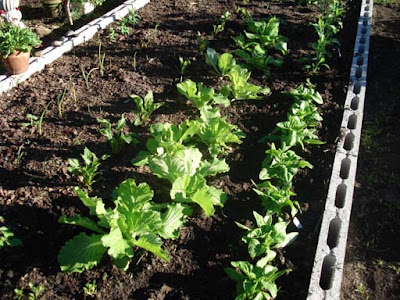If you put in the time, effort and money into growing your own vegetables, make sure they’re organic. You can easily add natural fertilisers that will add to the health and fertility of your soil without leaving behind man-made chemicals that might do you and your garden damage.
I use comfrey as a nitrogen fertiliser, a little blood and bone, seaweed extract, sulphate of potash, Epsom salts, compost tea, compost and chicken, horse and cow manure as my fertilisers and tonics. I’ll write a post on how I use all these next week.
A lot of people don’t dig their garden beds, but we always do as we believe it aerates the soil and makes things easier for our friend, the worm.
Some seeds can be grown directly in the soil. It’s wise to always plant root vegetables directly into the ground. They will suffer if they’re transplanted. Carrots and radishes can be grow together. The very small carrot seeds are difficult to sow far enough apart, if you add radish seed to the carrot seeds and sprinkle them along the drill, the carrots will take much long to germinate than the radishes do. The radishes will come up quickly, showing where the carrots have been sown, by the time the radishes are ready to be harvested, the carrots will be forming. Pulling the radishes out will give the carrots more room to grow.
Cucurbits, like pumpkins, squash, luffas, zucchini and cucumbers, should be placed in a mound built up a few inches above the surrounding ground. They’ll rot if they’re water logged.
All the legumes (beans and peas) should be planted in the ground. They like being sown into moist, fertile, well drained soil. Once you plant the seed, generally you don’t water it again until the seed has germinated. The obvious exception to this is if your surrounding soil is extremely dry, then you’d water the seed as little as possible.
Tomatoes are one plant that really benefit from being sown in a pot before being planted out in the garden. I’ll do a separate post on planting tomato seeds, hopefully next week.
Most of the other vegetables can easily be started early in trays. When they’re large enough you either plant them on or plant them out. Planting on means that when the plant is big enough, it’s transferred to another pot before being planted out. Planting out means planting in the garden bed.
The most important thing you need, beside your seeds, tray and seed raising mix, is an identification tag. Tag everything you plant, preferable with the name and date of planting. You’ll also need a spray bottle to spray water on the seedlings. Usually a hose, even on a fine spray, is too forceful for tiny seeds. Never let the trays dry out, those little seeds need to be moist – first to crack open the seed casing, then to help the plant grow. They will die without moisture.
Make sure you read your seed packet for the right time to plant. Planting seeds out of season will result in tall lanky plants that will struggle when you plant them out. Seeds need water and warmth to germinate, your seed packet will probably tell you how warm it needs to be, so be guided by that. Plant the seed according to the instructions. Generally you plant seeds according to their size – estimate the size of the seed and double it, that’s the depth at which it should be planted. For instance if your seed is ¼ inch, you would plant it ½ inch deep. If it’s 2mm, you’d plant it 4mm deep. Sow seed into moist soil and keep it moist by spraying with your spray bottle at least three times a day.
Growing vegetables from seed, particularly seed you've saved from your own vegetables the previous year, is very satisfying. You won't get it all right the first time but it's just a matter of learning from your mistakes and being careful.
Sharon will be announcing a seed swap soon. This is separate to our sewing and knitting swaps. You'll need open pollinated seeds or heirloom seeds to join the swap, so if you have no seeds yet, now is the time to get cracking.
MORE VEGETABLE GARDEN ADVICE:





